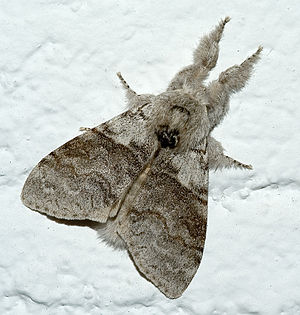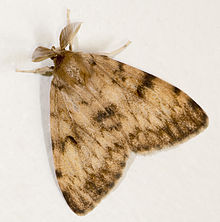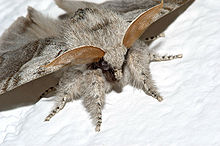Bearer spinner
| Bearer spinner | ||||||||||
|---|---|---|---|---|---|---|---|---|---|---|

Beech extensor foot ( Calliteara pudibunda ) |
||||||||||
| Systematics | ||||||||||
|
||||||||||
| Scientific name | ||||||||||
| Lymantriinae | ||||||||||
| Hampson , 1893 |



The carrier moth (Lymantriinae) are a subfamily of the Erebidae within the order of butterflies . They are also sometimes referred to as harmful spinners or woolly spinners . They occur worldwide with about 3,000 species, but are absent in New Zealand , Hawaii , the Antilles and New Caledonia . For a long time the taxon was in the rank of a family (Lymantriidae) in the superfamily Noctuoidea , but was set by Lafontaine and Fibiger (2006) after a revision of the superfamily on the subfamily level of the Erebidae.
features
The moths reach a wingspan of 25 to 50 millimeters and are medium to strong built. The males are usually smaller than the females. The front wings are 1.5 to 2.3 times as long as they are wide, the hind wings are similarly wide and strongly rounded. There are species in which the wings of the females are either missing or only reduced. The antennae are short and only reach a third to about half the forewing length. The males are pinnate or long combed. The animals have regressed or missing maxillary palps , the proboscis is also missing. At the metathorax they have tympanic organs .
The forewings have 12 wing veins with one anal vein (1b). The hind wings have 8 or 9 veins with two anal veins (1a and 1b).
Caterpillars
The caterpillars of the bearded moth are sometimes very hairy. Some caterpillars also have very conspicuous tufts of hair, which is also reflected in their species names, such as the sloe-brush spinner ( Orgyia antiqua ) and redtail ( Calliteara pudibunda ). Few species also have stinging hairs , such as the gypsy moth ( Lymantria dispar ) and the brown-tail ( Euproctis chrysorrhoea ). The caterpillars follow the anatomy that is typical for most butterflies with three pairs of breast bones, four pairs of belly bones and a follower .
Way of life
The moths are crepuscular or nocturnal, but some also fly during the day.
Harmful effect
Some species can be used as pests occur in agriculture and forestry, such as the gypsy moth ( Lymantria dispar ), the nun ( Lymantria monacha ) and the brown-tail ( Euproctis crysorrhoea ), which tend to periodically outbreaks. This can lead to damage to infested trees and bushes from defoliation. The designation of the subfamily as a harmful spinner goes back to this property. However, the majority of the species cause only minor damage or have no economic relevance at all.
Systematics
33 species have been described throughout Europe , of which 17 species occur in Central Europe .
- Tribus Arctornithini Holloway, 1999
- Black L ( Arctornis l-nigrum ) ( MÜLLER , 1764) A, CH, D
- Tribus Leucomini Grote, 1895
- Spinner poplar ( Leucoma salicis ) (L INNAEUS , 1758) A, C, D
- Tribe Lymantriini Hampson, 1893
- Nun ( Lymantria monacha ) (L INNAEUS , 1758) A, CH, D
- Gypsy moth ( Lymantria dispar ) (L INNAEUS , 1758) A, C, D
- Rust spinner ( Ocneria rubea ) (D ENIS & S CHIFFERMÜLLER , 1775) A, CH, D
- Soot Spinner ( Ocneria detrita ) (E SPER , 1785) A, D
- Ocneria atlantica (R AMBUR , 1837)
- Ocneria lapidicola (H constru -S CHÄFFER , 1851)
- Ocneria eos R EISSER , 1962
- Ocneria ledereri (M ILLIÈRE , 1869)
- Ocneria terebinthi (F REYER , 1838)
- Ocneria samarita S TAUDINGER , 1896
- Tribus Nygmiini Holloway, 1999
- Tribe Orgyiini Wallengren, 1861
- Beech extensor foot ( Calliteara pudibunda ) (L INNAEUS , 1758) A, CH, D
- Fir extensor foot ( Calliteara abietis ) (D ENIS & S CHIFFERMÜLLER , 1775) A, D
- Calliteara fortunata (R OGENHOFER , 1891)
- Gorse extensor foot ( Gynaephora fascelina ) (L INNAEUS , 1758) A, CH, D
- Moonspot brush spinner ( Gynaephora selenitica ) (E SPER , 1789) A, D
- Orgyia Antiqua ( Orgyia antiqua ) (L INNAEUS , 1758) A, C, D
- Corner spot brush spinner ( Orgyia recens ) (H ÜBNER , 1819) A, CH, D
- Heath brush binder ( Orgyia antiquoides ) (H ÜBNER , 1822) A, D
- Orgyia trigotephras B OISDUVAL , 1829
- Orgyia corsica (B OISDUVAL , 1834)
- Orgyia rupestris (R AMBUR , 1832)
- Orgyia aurolimbata (G UENÉE & DE V ILLIERS , 1835)
- Orgyia dubia (T AUSCHER , 1806)
- Orgyia splendida (R AMBUR , 1842); Species authorization disputed
- Orgyia algirica (L UCAS , 1849); Species authorization disputed
- Reed brush spinner or yellow leg ( Laelia coenosa ) (H ÜBNER , 1808) A, D
- Grief Spinner ( Penthophera morio ) (L INNAEUS , 1767) A
- Casama innotata (W ALKER , 1855)
- Albarracina warionis (O BERTHÜR , 1881)
supporting documents
literature
- J. Donald Lafontaine and Michael Fibiger: Revised higher classification of the Noctuoidea (Lepidoptera). Canadian Entomologist, 138: 610-635, Ottawa 2006, ISSN 0008-347X
- Axel Steiner, Ulrich Ratzel, Morten Top-Jensen, Michael Fibiger: Germany's moths . Bugbook Publishing, 2014, ISBN 978-3-00-043862-2 , p. 382.
Individual evidence
- ^ J. Donald Lafontaine and Michel Fibiger: Revised higher classification of the Noctuoidea (Lepidoptera) . Canadian Entomologist, 138: 610-635, Ottawa 2006, ISSN 0008-347X
- ↑ Lymantriinae. Fauna Europaea, accessed February 21, 2011 .
- ↑ Erebidae in Europe. Lepiforum eV, accessed on September 11, 2018 .
- ↑ Erebidae in Central Europe. Lepiforum eV, accessed on September 11, 2018 .